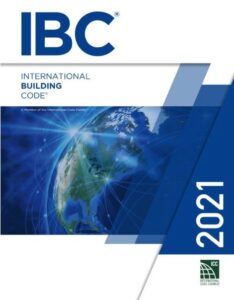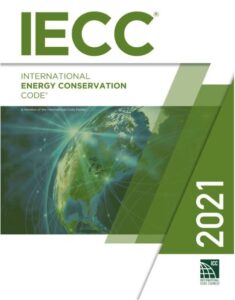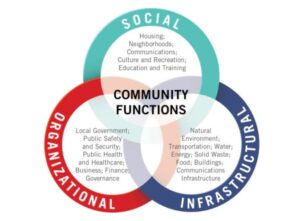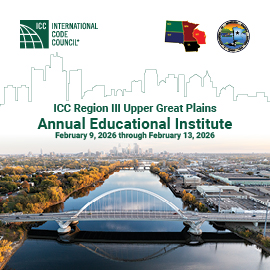
How ICC supports a holistic approach to sustainability and resilience
The International Code Council and Alliance for National & Community Resilience are focused on delivering solutions that help reduce energy and water use and enhance resilience
Buildings are the backbones of communities and are essential to the realization of sustainability and resilience goals. However, communities need the tools to effectively implement policies that drive progress. The International Code Council (ICC) and Alliance for National & Community Resilience (ANCR) are squarely focused on delivering solutions that help reduce energy and water use and enhance resilience.
Codes at the core
Building codes are finally getting the recognition they deserve as strong mechanisms to improve communities and effectively deliver safe, sustainable, and resilient buildings and communities. The Congressionally-established National Institute of Building Sciences (NIBS) found that the regular adoption of the International Building Code (IBC) and International Residential Code (IRC) provides an $11 benefit for every $1 invested. Benefits can be realized by multiple stakeholders including developers, occupants, lenders, and the community. Additionally, the application of up-to-date codes can help avoid the need for repair or rebuilding after a disaster, resulting in savings of approximately 1.5 million metric tons of carbon dioxide annually.
 Additional carbon savings can be realized through the application of building energy codes like the International Energy Conservation Code (IECC). The US Department of Energy found that the residential provisions of the 2021 IECC provide energy savings of 9.4% and carbon savings of 8.7% over the 2018 edition.
Additional carbon savings can be realized through the application of building energy codes like the International Energy Conservation Code (IECC). The US Department of Energy found that the residential provisions of the 2021 IECC provide energy savings of 9.4% and carbon savings of 8.7% over the 2018 edition.
These updates also lead to job creation and consumer savings. Updating to the 2021 IECC can generate over 22,000 jobs in the first year, and 632,000 jobs cumulatively over 30 years while saving the average homeowner $2,320 over the life of a typical mortgage. Since the 2006 edition, the IECC has delivered savings of nearly 40%. Since 2009, improvements in both the commercial and residential provisions have resulted in 700 million metric tons of carbon emissions avoided. Energy codes can also deliver significant resilience benefits including enhanced social resilience through reduced energy burdens for low- and moderate-income households and protection from extreme heat or cold events.
The content of the codes reflects considerable improvement, but their adoption is not uniform. Per the US Department of Energy and the Pacific Northwest National Laboratory, about half of the states have either no energy conservation code adopted statewide or have adopted older code editions that are roughly 20% less efficient than the current editions.
To help encourage states and localities to capture the energy and GHG savings in the 2021 IECC, the ICC launched the Code on a Mission campaign with a dozen supporting organizations to have about one-third of the US covered by energy codes meeting or exceeding the 2021 IECC by the end of 2023.
Making continued progress
Going forward, the ICC will continue to provide the tools communities need to progress. ICC board of directors approved a new energy and carbon framework in March 2021 that sets our priorities to deliver these tools. The framework includes a new scope and intent for future editions of the IECC requiring continual improvement in energy savings from edition to edition. The framework also includes provisions that lead to zero-energy buildings today and by 2030.
ICC is also developing resource documents that sit alongside the codes and provide communities with pathways to implement additional energy efficiency or GHG reduction policies—the first of which covers electric vehicle charging infrastructure.
 While significant progress has been made in reducing energy use and GHG emissions associated with building operations, how we construct buildings including the materials used and the construction process also can have a significant impact.
While significant progress has been made in reducing energy use and GHG emissions associated with building operations, how we construct buildings including the materials used and the construction process also can have a significant impact.
ICC recently announced its intent to develop a standard that supports the measurement and verification of GHG emissions across the building life-cycle including materials, construction processes, and operations. This standard will help designers, building owners, and governments understand the true impact of buildings in a consistent manner and support decision-making across all building performance attributes.
One process that aims to advance sustainability while also addressing societal and industry challenges, like housing affordability and a limited workforce, is off-site construction. ICC has recognized the opportunities off-site construction provides and the need for solutions to support its effective use. ICC has developed two new standards with the Modular Building Institute to facilitate the effective design, fabrication, and assembly as well as the inspection and regulation of off-site construction. A third standard is in the works to cover energy efficiency and water conservation opportunities in off-site construction.
As indicated above, building codes already provide significant resistance to hazards. However, the risks buildings will face over their lifetime are changing and will continue to change. Codes and standards will need to adapt to assure that they continue to provide the desired level of protection. ICC is working with code development and research organizations in Canada, Australia, and New Zealand through the Global Resiliency Dialogue to identify strategies to incorporate future-focused climate data into codes and standards. An International Resilience Guideline will be released later this year, providing a framework and principles to support increased climate resilience.
Building resilient communities
 Building codes are a fundamental requirement for resilient communities, but communities need additional policies that work alongside those codes to achieve true resilience.
Building codes are a fundamental requirement for resilient communities, but communities need additional policies that work alongside those codes to achieve true resilience.
ANCR has identified 19 different community functions that make communities great places to live and work, but also influence the resilience of the community in the face of shocks and stresses. ANCR is developing a coordinated set of Community Resilience Benchmarks to help communities understand their current resilience and identify pathways to improve. Martinsville, Virginia, and Oakland Park, Florida, recently completed the benchmarking process, providing valuable insight into their resilience.
Driving progress together
Achieving safe, sustainable, and resilient buildings and communities requires a holistic approach focused on the development and deployment of policies and practices aligned with community goals.
No matter your role in the building industry, there are opportunities to contribute to improved buildings. Participate in the model code development process or support adoption of codes at the state and local level. Engage clients and communities in conversations on the importance of integrating building sustainability and resilience strategies into projects. Build relationships with professionals from other disciplines and work collaboratively to support a holistic approach to resilience. Sustainability and resilience are a team sport.








